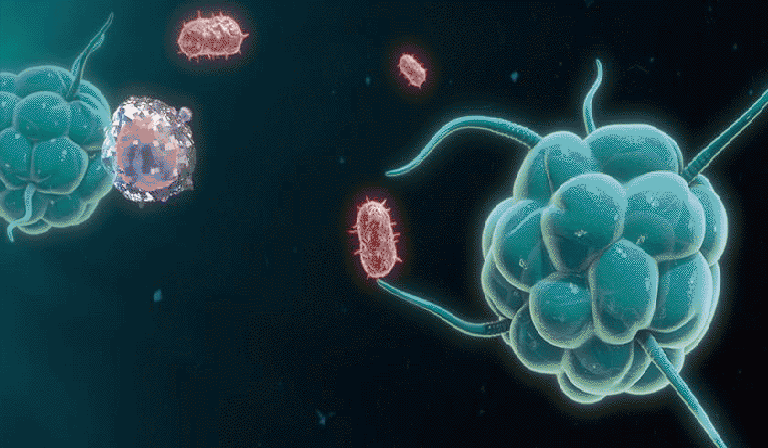Table of Contents
ToggleImmunology:
It is the branch of biology that covers the study of the immune system of organisms. It was Russian biologist Itya Ilyich Menchnikor who boosted studies on immunology. Menchnikor first observed the phenomenon of phagocytosis in which the body defends itself against the foreign body and coined the term immunology. Immunology has applications in numerous disciplines of medicines, particularly in the field of organ transplantation, oncology, virology, bacteriology, psychiatry, and dermatology.
Immunity in organisms is the ability to recognize foreign material and to resist the development of diseases even after receiving an infective dose of a virulent pathogen, its toxin, or an allergen. Sir Mac Farlan Burnet, defined immunity as “the capacity to recognize the intrusion of material foreign to the body and to mobile cells and cell products to help remove that particular type of foreign material with greater speed and effectiveness”.
Components of the immune system are typically cellular in nature and not associated with any specific organ but rather embedded or circulating in various tissues located throughout the body. Immunity involves both specific and non-specific components. Non-specific components act as barriers or eliminators of a wide range of pathogens irrespective of their antigenic makeup. Other components of the immune system adapt themselves to each new disease encountered and are able to generate pathogen-specific immunity.
An immune system contains Innate and adaptive components.
-
Innate Immunity
Innate immunity is also called as native immunity, inborn, genetic, and natural. It is a non-specific type of defense that is accomplished by providing different types of barriers to the entry of foreign agents into our bodies. Innate immunity consists of four barriers
1. Physical Barriers
Skin in our body is the main barrier that prevents the entry of microorganisms. Mucus coating of the epithelium lining, the respiratory, gastrointestinal, and urogenital tracks also help in trapping microbes entering our body.
2. Physiological Barriers
The acid in the stomach, saliva in the mouth, and tears from the eyes all prevent microbial growth.
3. Cellular Barriers
Certain types of leucocytes (white blood cells) of our body like polymorpho-nuclear leucocytes and monocytes are natural killers (type of lymphocytes) in the blood as well as macrophages in tissue that can phagocytose and destroy microbes.
4. Cytokines barriers
Virus-infected cells secrete proteins called interferons which protect non-infected cells from further viral infection.
-
Adaptive immunity
Adaptive immunity is also known as acquired immunity is pathogen-specific immunity. It is characterized by memory. This means when our body encounters a pathogen for the first time it produces a response called primary response which is of low intensity. Subsequent encounters with the same pathogen illicit a highly intensified secondary or anamnestic response. This is due to the fact that our bodies appear to have a memory of the first encounter. The primary and secondary responses are carried out by two special types of lymphocytes present in our blood that is B-Lymphocytes and T-Lymphocytes.
B-Lymphocytes produce an army of proteins in response to pathogens in our body to fight them. These proteins are called antibodies. The T-cells themselves do not secrete any antibodies but help the B-cells to produce them.
Antibodies are immunoglobulins (Igs) that are produced in response to antigenic stimulations. Thus all antibodies are immunoglobulins but all immunoglobulins are not antibodies. The antibodies may be bound to the cell membrane or they can be free. Antibodies are produced by B-lymphocytes and plasma cells. The mature plasma cell produces antibodies at an extremely rapid rate of about 2000 molecules per second. The simplest antibody molecule is Y-Shaped. Each antibody molecule has four peptide chains, two small called light chains and two longer chains called heavy chains.eg, IgG, IgA, IgM, IgD and IgE.
In order to understand the concept of immunity, we need to understand how antigens and antibody interacts.
Each antigen causes the formation of a specific antibody. Interaction between antigen and antibody involves non-covalent bonding of antigen determinant (epitope) to the variable region (complementary determining region) of both heavy and light immunoglobulin chains. The antibody molecule is the basic functional unit of the immune system because an antibody fits precisely with an antigen and an antibody that binds to one antigen cannot bind to another antigen. The antibodies fight the antigen in five different ways
- Neutralization
- Agglutenation
- Precipication
- Opsynization
- Compliment activation.
If you are looking for someone who can help you with biology-related assignments, you are at the right place. We at allassignmentsupport have designed “Assignment Help Services” especially for students who are struggling with their assignments or have no time to complete them. Just send us one line message of “I need assignment help” and our experts will be happily ready to help you. So what are you waiting for, Hire an Expert now!











